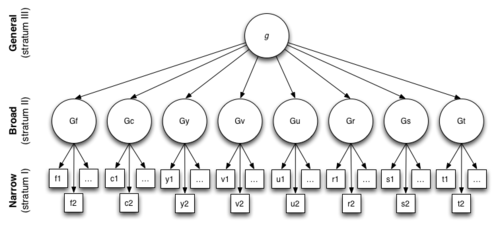Cattell-Horn-Carroll model
The Cattell-Horn-Carroll model , or CHC model for short , is a result of the development of intelligence theories . These understand the generally measurable intelligence ( intelligence quotient ) as the result of several factors that mutually reinforce each other. The name of the model is derived from the development stages according to Raymond Bernard Cattell , John L. Horn and John B. Carroll .
development
The development is based on the statistical factor analysis by Charles Spearman , who found out when measuring various intelligence tests that they are positively correlated with one another. The correlations were not high, but they did suggest that there is a general factor of intelligence . He formulated this “general” g-factor in 1923. Statistically, he was also able to work out area-dependent factors that are not present in all but a few similar tests, which he called “specific” s-factors - in particular correlated performance in mathematical, verbal and spatial Testing. These s-factors can be viewed as subordinate to the general g-factor.
Raymond Cattell dismantled the test results differently, in that he recognized that the specific factors can be traced back to a person's previous knowledge, for example in terms of vocabulary range and analogies. These achievements crystallize over a person's life path. Accordingly, he split the g-factor into a fluid and crystalline intelligence , referred to as the Gf-Gc model for short. He formulated this in 1941. Whether the largely innate fluid intelligence can be permanently increased through training has repeatedly been the subject of studies. More recent results show that Gf and Gc can be located in different brain areas, namely long-term memory and its visualization in Gc, and short-term memory and sensory attention in Gf. Both have an underlying capacity and their effective usability is influenced by training.
Cattell's theory was the basis for the factor analysis of his student John Horn, who expanded the Gf-Gc model in his study presented in 1966 and now recognized ten factors with a broad effect. In the following, these were formulated as nine named factors: Gf, Gc, Gy, Gv, Gu, Gr, Gs and Gt. The resulting Catell horn model continued to be called the Gf-Gc model for short. Over the following decades this model was further substantiated by series of tests.
Based on the available data, John Bissell Carroll refined this two-tier model to a three-tier model, in which the nine factors were broken down into 70 factors that had a limited effect, which he first presented in 1993 (three-stratum theory). The resulting CHC model was expanded and reformulated in the following years by various researchers, including McGrew (1997), McGrew and Flanagan (1998), and Schneider and McGrew (2012).
Factors
Carroll's original ten factors:
- Gc (Comprehension-Knowlegde): the understanding of existing knowledge and the knowledge thus acquired
- Gf (Fluid Reasoning): the ability to reason, especially inductive and deductive thinking to work out new concepts
- Gq (quantitative knowledge): the ability to deal with numbers and the formulation and use of scales and their connection
- Grw (Reading & Writing Ability): the ability to read and write
- Gsm (Short-Term Memory): the ability to hold a lot of information in short-term memory and to be able to access it precisely within a few seconds.
- Glr (Long-Term Storage and Retrieval): the ability to store some information in long-term memory and to be able to access it quickly later.
- Gv (Visual Processing): the ability to analyze and link visible stimuli, in particular pattern recognition and subsequent visualization
- Ga (Auditory Processing): the ability to analyze and link audible stimuli, especially speech, even in a disturbed environment.
- Gs (Processing Speed): the speed for capturing (formulating) knowledge, especially under pressure (typically a few minutes)
- Gt (Decision / Reaction Time / Speed): the speed for conscious reaction to stimuli (typically a few seconds or parts of a second)
The factors Gy (Memory) and Gr (Retrieval) retrieval speed are other formulations that summarize nine factors. Gu (Auditory) was renamed.
McGrew suggests an expansion to include separate factors Gkn, Gp, Gps and additional sensory factors Gh, Gk, Go.
- Gkn (Domain-specific knowledge): subject-specific in-depth knowledge
- Gp (Psychomotor ability): the sequence of steps in cognition
- Gps (Psychomotor speed): the speed of mental chronometry
- Gh (tactile processing): Analysis of touch (especially the fingers)
- Gk (kinesthetic processing): Analysis of movements and tension (especially of the body)
- Go (olfactory Processing): Analysis of smells
These factors primarily represent skills beyond schooling.
See also
- Learning type test - effectiveness of knowledge acquisition
- Intelligence theories - multidimensional instead of hierarchical models
